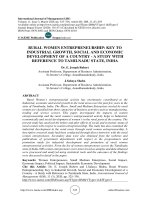Economic growth and economic development 374
Bạn đang xem bản rút gọn của tài liệu. Xem và tải ngay bản đầy đủ của tài liệu tại đây (39.95 KB, 1 trang )
Introduction to Modern Economic Growth
theory and in other areas of macroeconomics. Moreover, while some problems naturally lend themselves to analysis in discrete time, other problems become easier in
continuous time. Some argue that this is indeed the case for growth theory. Irrespective of whether one agrees with this assessment, it is important to have a good
command of both discrete time and continuous time models in macroeconomics,
since it should be the context and economic questions that dictate which type of
model one should write down, not the force of habit. This motivated our choice of
giving roughly equal weight to the two sets of techniques.
There is another reason for studying optimal control. The most powerful theorem
in optimal control, Pontryagin’s Maximum Principle, is as much an economic result
as a mathematical result. As discussed above, the Maximum Principle has a very
natural interpretation both in terms of maximizing flow returns plus the value of the
stock, and also in terms of an asset value equation for the value of the maximization
problem. These economic intuitions are not only useful in illustrating the essence
of this mathematical technique, but they also provide a useful perspective on a
large set of questions that involve the use of dynamic optimization techniques in
macroeconomics, labor economics, finance and other fields.
Finally, to avoid having the current chapter just on techniques, we also introduced a number of economically substantive applications of optimal control. These
include the intertemporal problem of a consumer, the problem of finding the optimal
consumption path of a non-renewable resource and the q-theory of investment. We
also used the q-theory of investment to illustrate how transitional dynamics can be
analyzed in economic problems involving dynamic optimization (and corresponding
boundary conditions at infinity). A detailed analysis of optimal and equilibrium
growth is left for the next chapter.
This chapter also concludes our exposition of the “foundations” of growth theory,
which comprised general equilibrium foundations of aggregative models as well as
an introduction to mathematical tools necessary for dynamic economic analysis. We
next turn to economically more substantive issues.
360









